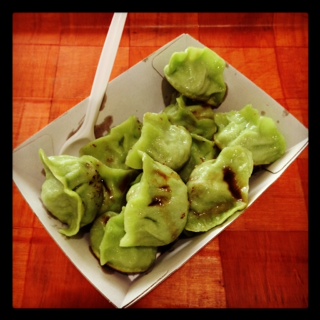I could make up some elaborate tale about the above su sai jian jiao (which translates as pan-fried vegetable dumplings).
I could say how the GPS didn't even know how to get to the hidden eatery in a barely converted former dry cleaners in some obscure neighbourhood.
I could self-righteously say there were only Chinese patrons there and that I could only order by pointing to the exotic green ones steaming on the neighbouring table.
I could tell you the owners greeted this big white guy like a visiting dignitary - the way they might have greeted an exotic green one (guy, that is).
I could tell you about the owner's sharing the secret of the unusual imported flour they use to make their dumplings green.
Or, I could just tell you the facts ma'am.
Fact 1: I bought these dozen dumplings for $9.80 at the food court of my local suburban shopping mall, Castle Towers, in Castle Hill.
Fact 2: The Lok Lok Dumpling House shares the food court with McDonalds and Pizza Hut.
Fact 3: Their vegetable filling is a lovely and juicy blend of shitake mushrooms, bean sprouts, buk choy, watercress and Asian cabbage; the tender dough's green because they add food colouring to it.
All of which says a fair bit about the rearranging kaleidoscope that are the suburbs of Sydney. Until recently, Castle Hill was Tip Top white bread, cricket on Channel 9, and Bibles. Lots of Bibles. That's clearly changed as - in the last five years alone - Sydney's China-born community has grown by nearly 40%. Wonderfully, my own street now has five Asian families where it had none five years ago. (Hello capital appreciation!)
Politicians can be silly to talk about Asia as someplace we should "relate to" or "understand more" or "seek greater engagement with". That makes it sound like Asia's out there someplace. Maybe, they just haven't leant over the backyard fence for a while.
Asia isn't someplace else - it's Castle Hill, Strathfield, Hurstville, Parramatta, Chatswood, you name it.
Chinatown's an increasingly a redundant term; it's just our town.
Indeed, Asian is our new normal - with all the social, economic and cultural benefits that go with it.
Including really good dumplings. Lok Lok's are as good as I've had in "only for locals" backstreets in Beijing, Shanghai and Hong Kong. Maybe, part of the reason is our amazingly fresh and readily available Aussie ingredients. Maybe, part of the reason is really proud migrant owners where everybody chips in.
Indeed, in the back of the kitchen at Lok Lok, the owner's dad was there feeding his 4 year old grandson (in a uniform from a local public pre-school) some dumplings. In the usual way of 4 year old dictators, he barked orders in English: "Green one!" "More!"
On a lot of different levels, I agree.







